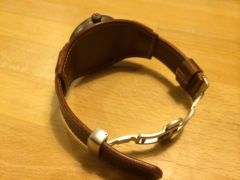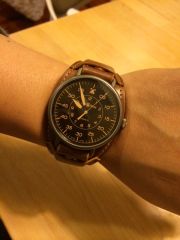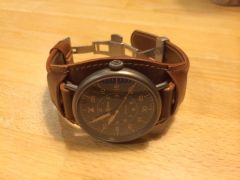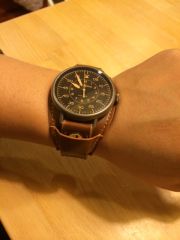-
Posts
719 -
Joined
-
Last visited
Content Type
Profiles
Forums
Events
Blogs
Gallery
Everything posted by Andrew Chee
-
Yes it is still available. Andrew
-
From the album: Bund Watch Strap
-
From the album: Bund Watch Strap
-
From the album: Bund Watch Strap
-
From the album: Bund Watch Strap
-
What's that thing that looks like an extra pulley on your sewing machine? Andrew
-
For the fee I would think that any standard servo motor would do. There's not too much torque involved in feeding leather through and a servo will give you all the speed control you would need. Andrew
-
I think that that's possible and probably relatively easy to do. There's the belt that goes from the motor to the machine. That pulley on the machine controls the knife. From that pulley there is another belt that goes to another pulley on the back of the machine. That pulley controls the feed wheel. Remove the belt between the two pulleys and rig up another motor to run that back pulley and now you have independent control over blade speed and feed speed. The easiest thing to do is to buy a cheap clutch motor and connect that to the knife pulley. You can rig it so the motor is constantly engaged from the moment you turn the power on. That way, you have a constant speed knife. Then you use your servo motor to control the back pulley so you have better feed speed control. Andrew
-
I use about 2oz for wallet interiors. I guess it just depends on how thick you want the overall material to be. Using a splitter is good but to consistently split leather down to 2oz is difficult unless you have one of those expensive band knife splitters. Fixed blade splitters can do it but the results can be very inconsistent. This is an issue inherent in the design of fixed blade splitters. You can purchase leather split to the thickness you want but here you are limited to only certain leathers and certain dealers. Basically Wicket and Craig will split any of their leathers for you. Hermann Oak probably will but you have to buy quite a few hides at a time. You can purchase most carving/skirting leathers in different thicknesses but that's about it. That's the problem with purchasing pre-split leather. You only have a few choices. If what you want falls within these choices then I would say purchase pre-split leather. If not, you might have to go with a splitter. Andrew
-
I bought the used one on campbell Randall's website. Atom gl27. You can find it on their website. Andrew
-
So a fixed knife splitter technically can do that but what I've found is that I would waste a lot of leather because the resulting thickness was often times inconsistent from one piece of leather to the next. Because of the inherent nature of the design. I originally used the smaller splitter but found that I could not split things like the main wallet panels because the limit in width so I purchased the wider splitter. It all depends on what you need it to do. Andrew
-
What thickness are you planning on splitting from and splitting to? If you want to split chrome tan leather then you will need a band knife splitter. A stationary knife splitter will not split that stuff well. I have owned all sorts of splitters from a pull through type splitter to a 6" crank stationary blade splitter to a 14" stationary blade splitter to a band knife splitter ( getting delivered now). Stationary blade splitters are good for firmer veg tan leathers. Since the rollers push the leather against a fixed blade, a lot of pressure is placed on the leather and chrome tan leathers generally don't have the body to stand up to it. Firmer chrome tan leathers may though. With that said, fixed blade splitters are not great for consistency. Especially as you try to split thinner. For example, I regularly want to split a 5oz skin down to 2.5oz. This is firm veg tan leather. The problem is that because of the pressure that the splitter puts on the leather, the thickness output can change from one end of the leather to the other. If you are splitting a piece that runs from the spine towards the belly, the spine end can come out over an oz or two thicker than the belly end. This is not because of any flaws in the splitter but just the inherent nature of fixed glad splitters. Band knife splitters don't have this problem because the knife does not put as much pressure on the skin. There are other considerations with a band knife splitter and I can talk about those if you like. But basically band knife splitters will give you the most flexibility and consistency but of course they are by far the most expensive. If you want to go with a stationary blade splitter and want to be able to split something wider than about 5-1/2" then the only choices are the Cobra 14" crank splitter and the artisan 20" crank splitter. If you can live with a 5-1/2" wide max then there are used landis and American splitters. I own an American and a Cobra. They are both good quality and work well. They just have the limitations I described inherent in the design. The quality is great though. Now on a self serving note. Since I purchased the band knife splitter, I will be selling both of my fixed blade splitters soon if you are interested. Andrew
-
Just saw this thread again. Wanted to close up on my earlier issues with the thread unravelling. I figured it out. Looks like the thread guide hole on the needle bar wasn't finished very well (non-OEM part) and was rubbing the thread and causing it to shred and unravel. I put some polishing compound on a string and cleaned up the hole and how the issue is resolved. Andrew
-
#69 polyester is going to be your best bet. Any thicker and your home machine won't be able to handle it. As you said, cotton thread is not as durable and (waxed) linen thread is not an option for that type of machine. Andrew
- 3 replies
-
- sewing machine
- thread
-
(and 2 more)
Tagged with:
-
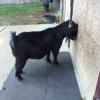
How Can I Reduce Thickness Of Leather Without A Splitter?
Andrew Chee replied to thekid77's topic in How Do I Do That?
The real answer is you can't. I doubt there's anyone in the world that can do a consistent split from 4 to 2 oz with a safety skiver. I have a fixed blade splitter and I can't always get a consistent split from 4 to 2 oz. If you want good quality results you're either gonna have to get a splitter it just buy thinner leather. Andrew -
Hello all, I've been interested in getting a needle and awl machine for a while. I don't do heavy leather like saddles and harnesses. I mainly want one for doing my straps, belts, and wallets. I mostly work with veg tan leather but the thicknesses only go up it maybe 6-8oz total. I mostly use a 138-207 size thread. I want a needle and awl machine primarily for a better looking bottom side stitch. Is there a machine out there that's good for this lighter work? You always hear about these machines for heavier applications. But is there one good for lighter ones? Thanks, Andrew
-
I have a Singer 31-15 sewing machine set up for sewing leather. The machine is in excellent working condition. It is set up with an extra large fly wheel to help slow down the machine and increase punching power. The machine includes: Servo motor (much easier control) Adjustable edge guide Various metal and rubber roller feet Various other metal and teflon feet An assortment of leather point needles Asking $400. Local sale only since it's not worth shipping. Please email me if you have any questions. Thanks, Andrew You can also see the listing here: http://sfbay.craigslist.org/eby/for/4595816304.html
-
You are asking probably the toughest question to answer in terms of leather sewing machine. The answer to the question is "it depends". Actually, the real answer is that there is no one machine that will do everything you want. Since you're taking classes at FIT then I am assuming that you are working more with "fashion" leather. By that I mean softer chrome tan leathers that are in the 2-4oz thickness range? If that's your primary medium then go with something like a techsew 2700 or even better, a pfaff 335. If your primary sewing medium is more in the veg tan saddle leather 6oz+ range then go with a 5100 or any of the other 441 clones out there. The heavy machine will sew heavy stuff well but won't sew light stuff well. The 2700 or 335 is more of a medium weight machine and will sew light to medium weight well but won't sew heavy stuff. By heavy here I mean 8+oz veg tan leathers. If you want to cover all your bases then do what I did. Buy three machines. One for each weight level :D Andrew
-
Go check out Sheridan leather. They have the best rivet setting tools I've used. Andrew
-

Bona Allen And Us Mail Bags. How Were These Bags Stitched?
Andrew Chee replied to unclecol's topic in Leather History
I've made a few of those. Pretty simple. They're basically sewn inside out and then turned. Most probably machine sewn. Back then they used pretty thick leather. Probably in the 7-8oz range so you'll have to use a 441 clone class of machine to sew those. They have a folded piping (no piping core) on those bags. The best way to do that is to use a lighter thread and sew the piping onto the main bag panels and then sew the main bag panels to the gusset. Too difficult if you try to sew three pieces of leather together at once. The leather is definitely a straight veg tan leather. If you use your basic strap leather you can get that look after a few years of use and sun. If you want to get that worn-in look faster, you'll have to do some distressing on them. Andrew -
There's a guy in Atwater CA selling one. It's on craigslist. Pretty sure hey won't ship though... Andrew
-
Cool solution. Where did you get the parts made. We're they expensive? Andrew



